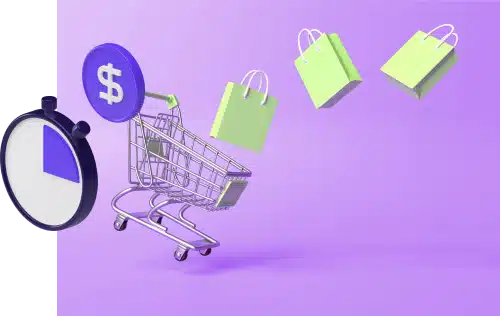Want to sell items on Facebook but unsure of where to start? You’re not alone; many struggle with the same predicament.
I’ve been in your shoes years ago before I mastered the art of selling on Facebook—and I’m here to show you how.
Facebook is one of the largest social media platforms in the world, with nearly 40% of the population using Facebook at least once a week.
With such a large market, it’s only natural to want to try your luck selling your items in the hundred of marketplaces it offers.
Luckily, selling on Facebook is a simple affair. This article shows you how to sell on Facebook, as well as the advantages and disadvantages of doing so.
Why You Should Consider Selling on Facebook
With nearly 3 billion monthly active users, Facebook is an excellent medium to reach your target audience and build a brand.
Here are some reasons why you should consider selling on Facebook:
- Low-cost marketing: Whether it’s through Facebook ads or Facebook marketplaces, the site offers flexible and low-cost marketing options to sell and popularize your brand.
- Simplified buying and selling: The listing process on Facebook is as simple as can be. All you’ll need to do is to take pictures of the items you’re selling and upload them to the site using your PC, mobile phone, or tablet. You can post the images on your selected Facebook group or marketplace with a short description, a price, and a location.
- Customer engagement: Facebook streamlines customer engagement. The site provides plenty of opportunities for both buyers and sellers to interact with one another, whether it’s through private chat or Facebook comments.
- High visibility: With millions of daily active users, Facebook gives you the highest chance of market visibility. This is especially true if you sell your items in groups where your target audience engages. It also lets you share links to gain a bit more traffic on your website.
Problems With Selling on Facebook
Despite its perks, Facebook has its fair share of disadvantages and problems. These include:
Safety Concerns
Anyone and everyone can make a Facebook profile, which can raise safety concerns for sellers. Facebook doesn’t vet buyers, so you can never rule out the possibility of getting scammed.
Fraudulent buyers scam sellers with three primary methods: a verification code, a prepaid shipping label, or an overpayment.
In the first scam, buyers ask you to send a text to arrange an item pickup. The scammer will register your phone number in Google Voice, triggering a verification code sent to your phone.
The scammer will ask you to send the code back to “verify” that you’re a real person and not a bot. In reality, they’re doing this to create a Google Voice number under your name, which can result in identity fraud.
Similarly, beware of buyers asking you to provide them with a prepaid shipping label.
The buyer can request to have the item sent to a different address and claim that the package was never received, forcing you to either send another item or ask for a refund.
As for the overpayment scam, the buyer would send you more than you requested and ask for the extra money back. In such cases, the buyer would use a stolen card or a counterfeit check.
When the bank catches up, they’ll reverse the payment process—taking back the original payment and the “overpayment.” At this point, you’ll have already sent the items.
Some Products Are Prohibited
The advantage of running your own website is that you can sell whatever you want as long as it’s not illegal. Facebook doesn’t give you the same leniency. Here’s a list of products that you can’t sell on Facebook:
- Prescription or recreational drugs
- Tobacco products
- Alcohol, including but not limited to wine, beer, and spirits
- Medical equipment
- Weapons, explosives, and ammunition
- Subscriptions, digital content, and downloads
- Currency, both real and virtual
- Physical services (housekeeping, etc.)
Like most websites, illegal products and services aren’t allowed. Counterfeit products, adult products, offensive products, and gambling services may get you banned from the site.
Fierce Competition
With millions of people using Facebook as a marketing platform, the competition is fierce.
Gaining a loyal audience isn’t as easy as, say, Instagram, YouTube, or Twitter, where customers can regularly tune in to your account and purchase items.
If you’re not an established brand, you may find it difficult to earn a following. Recognition takes time and effort, and Facebook makes it even harder by putting you in an unstable selling environment.
What You’ll Need to Sell on Facebook
Here’s what you need to get started on Facebook selling:
- Active Facebook account: Naturally, you need an active Facebook account to start selling on the platform. You need to be at least 18 years old to sell on Facebook Marketplace.
- Delivery service: You can boost your sales by offering local delivery. Many people dislike meeting up one-on-one with sellers, limiting your customer reach. Companies like DoorDash can help you deliver the items you’re selling to the buyer in a timely manner. You can also opt for Facebook Marketplace’s delivery options for a small fee.
- Decent photography skills: Your product won’t sell if it doesn’t look good in pictures. You need to make sure your photo stands out to catch the attention of potential customers. You want people to click on your photo as they’re scrolling through hundreds of items on the marketplace.
What to Sell on Facebook
Here are the top-selling product categories on the Facebook sell space:
1. Home Furnishings
Furniture and appliances are in high demand on Facebook marketplaces. Buyers opting to renovate their house with new furniture or replace an old appliance will come to Facebook to snag a good deal.
Whether it’s rugs, couches, or vintage items, you’re spoiled for choice. Just make sure the items you’re selling are functional and clean.
Why These Products Sell Well
New furniture can cost an arm and a leg, so homeowners often opt for nearly new or gently-used second-hand items when renovating their homes.
They won’t need to empty their pockets for name-brand household items and you’ll be able to sell your unwanted items. It’s a win-win!
2. Clothing and Fashion Accessories
Women’s, men’s, and kids’ clothing sell like hotcakes on Facebook Marketplace.
Buyers can use keywords to find specific items or browse through second-hand clothing pages in search of a brand-name item.
This approach lets you sell your old clothing, thrift shop finds, vintage clothes, or upcycled items.
Why These Products Sell Well
Those who constantly switch up their fashion style are always on the lookout for clothes to try out. Young shoppers in particular are constantly searching for unique pieces and inspiring looks to stand out from the rest.
The most commonly bought clothing items on the Facebook marketplace include:
- Boots
- Scarves
- Vintage clothing
- Neon-ruffed sleeves
- Sunglasses
- Oversized apparel
- Embroidered apparel
- Jackets (puffer jackets, coats, denim jackets, leather jackets, etc.)
- Hand-made accessories
3. Electronic Appliances
If you’re good with technology and fixing up old appliances, you might find it advantageous to sell electronic appliances on Facebook, second-hand or otherwise.
Electronic devices are expensive, so finding a fully-functional item at nearly half the price is a deal that many people can’t pass up.
Why These Products Sell Well
Selling used or barely-used electronics and household appliances allows you to get rid of the item you’re no longer using and make a profit out of it.
You can also purchase faulty electronics for a reduced price, fix it up, and sell it for a profit. Just make sure to purchase gadgets that hold up their value over time.
Here are the best electronic items/appliances to sell:
- Apple products (Apple watches, MacBooks, iPhones, etc.)
- Videogame consoles (Xbox, PlayStation, Nintendo, etc.)
- Handheld cameras
- Home video cameras
- Vintage audio equipment
- Limited edition electronics and collectibles
The profitability of reselling electronic items depends on the product’s demand, condition, and market value.
With enough planning and research, selling electronics can be an excellent way to earn extra cash.
How To Sell on Facebook: Step-By-Step Instructions
Ready to earn big money by selling items on Facebook? Follow these steps:
Step 1: Choose Your Prefered Facebook Platform

There are dozens of ways to sell on Facebook, but the most common is through Facebook Marketplace, Facebook shops, and Buy and Sell Groups.
Facebook shops are suitable for small-business owners looking to build an audience and sell non-physical items.
Business owners can use their Facebook business page to grow their brand, boost sales, and advertise their products without the fear of getting buried amongst other ads.
Facebook Marketplace is much like Craigslist, with users posting classified ads and person-to-person exchanges of products and payments. It also offers on-site checkout and shipping options to accommodate sellers and small businesses.
Buy and Sell Groups are for those that target a niche audience. These groups can be a good way to build your brand on a local level.
Step 2: Take Eye-Catching Product Photos
Once you’ve decided where you want to post your items, it’s time to polish your picture-taking skills.
Showcasing high-quality photos significantly increases your chance of getting sales.
Remember: customers are drawn to images first and text second. If the photo you posted catches their interest, they’ll read the description and perhaps even inquire about a price.
The photo must appear professional and show enough details to effectively sell your product. People have limited time and patience to read text or product descriptions, so you need to let the photo do all the talking for you.
Step 3: Post On Facebook
If you want to use Facebook Marketplace to sell your products, click the Marketplace button on the Facebook menu and click Create New Listing.
From there, you’ll be given three options: Items for Sale, Vehicle for Sale, or Home for Sale/Rent. Select Items for Sale.
Fill out the listing information, making sure you add a high-quality photo and an engaging product description.
It’s also wise to note down the condition of the product (new, nearly new, gently used, used), the price, and any other additional details like SKU, brand, or product tags.
Click next, then post.
To sell through a Facebook shop, you’ll first need to create a Facebook Business page. You can either create an entirely separate account or connect it to your personal Facebook page.
Add a Shop section to the page, create a catalog, and set your shipping and returns policy.
Selling through Facebook Buy and Sell is much like selling in Facebook Marketplace but without an integrated checkout or delivery system.
Join the group you want to sell in and click Sell Something at the top of the page. Post your photo, description, and price, then press Publish.
Things to Consider When Selling on Facebook
Before selling on Facebook, consider the following factors:
- Facebook Ads: If you’re running a Facebook Business page, you may want to opt for a Facebook ad to market your product. As of 2023, the average cost-per-click of Facebook ads is $0.975.
- Preferred payment method: When selling items on Facebook, make sure you state your preferred payment method. Apple Pay, PayPal, and Google Pay are all good options as they don’t directly reveal your banking information or phone number.
Frequently Asked Questions
How Much Does it Cost to Sell on Facebook?
Selling on Facebook comes at the low price of $0 if you handle shipping yourself. If you decide to use Facebook Marketplace’s shipping, you’ll need to pay a fee of 5% per shipment or a flat fee of $0.40 for items less than $8.
Is it Worth Selling on Facebook?
Absolutely! Selling on Facebook is cheap and easy. It’s one of the best platforms to sell your products to a large audience.
Similar Tutorials to Check Out
You might find these articles relevant:
- How to Sell on Etsy: A step-by-step guide on how to sell on Etsy, including relevant details such as Etsy’s pricing policy.
- How to Sell on Poshmark: With a platform of 80 million users and over 200 million available listings, Poshmark might be the ideal website for selling new and secondhand clothing for women, men, kids, and pets.
- How to Sell on Instagram: From partnering up with influencers to running Instagram ads, this article shows you how to sell your products on Instagram without the need for a business license.
Wrapping Up
There you have it; our guide on how to sell on Facebook! Facebook houses one of the biggest marketplaces in the world, receiving millions of visitors each month.
With the right strategy, you could potentially earn thousands of dollars by selling new, nearly new, or used products.
We hope you found this article informative. If you have, why not give it a share? Thank you, and good luck!









